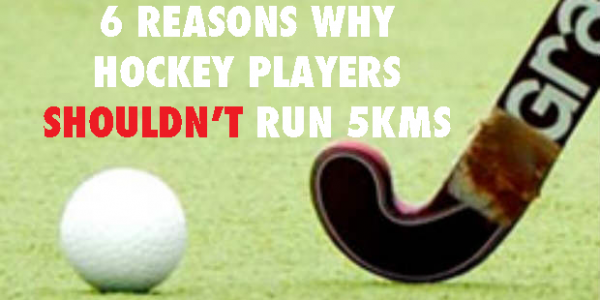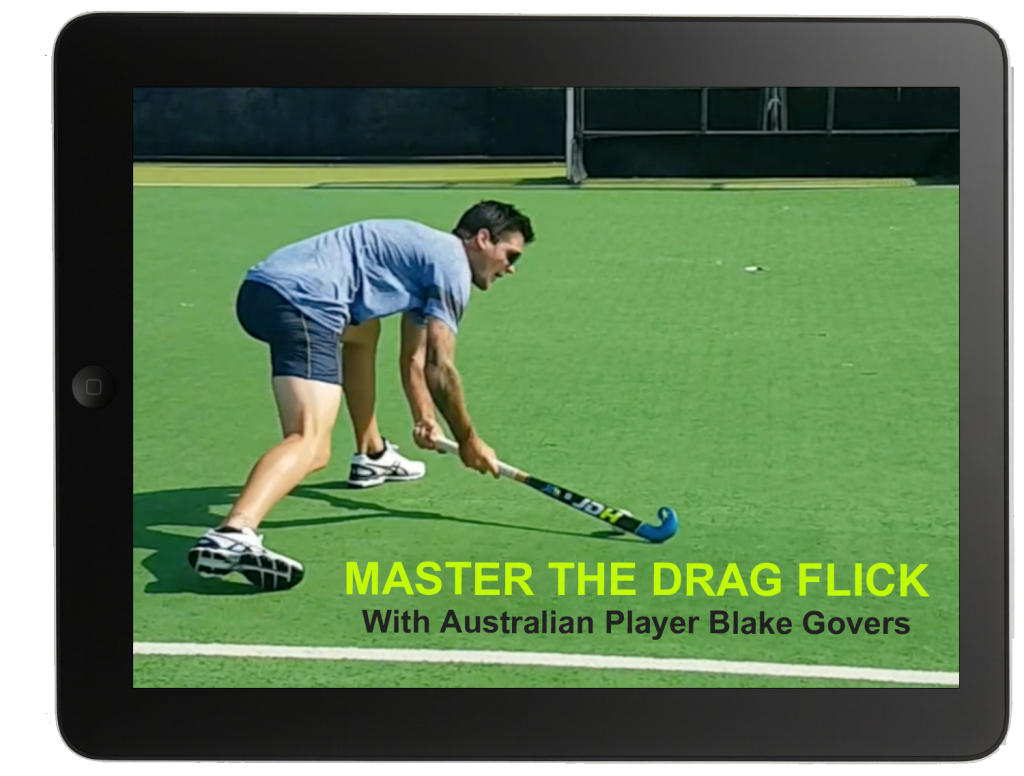When it comes to field hockey fitness – have you ever thought something along the lines of:
“I need to get fitter as a hockey player”
I hear this kind of statement a lot, so if you have ever thought or said this yourself then my first question to you is, what are you actually doing to get fitter?
Often when I ask people this question, I get one of these three responses:
1. I am not doing any extra fitness myself or
2. I will go for a jog, 5km or 10km runs or
3. I am doing everything I can, I train really hard; normally about 6-7 days a week
Now there are a few things wrong here.
Answer #1: indicates that you are either: not committed, haven’t found your deep burning motivation yet or you haven’t sat down and set yourself clear goals with objectives. Often people here will use lack of time or laziness as an excuse but may just be struggling with low levels of focus and motivation. This can be changed with a bit of mindset coaching which would be the first step.
Answer #2: indicates that you want to improve but you don’t really know how to do it effectively and probably need a bit of guidance as to how you can be more productive with your time. This is a typical answer that I hear the most. Think about it… When do you ever run 5km at the same pace in hockey?
Answer #3: indicates that you are very serious and dedicated to improving but you are probably doing too much. You may actually be working too hard and not working smart enough. I know what this is like because this used to be me, but if you carry on this way you will probably spend more time injured than playing, trust me I’ve been that person. For those who are serious about taking their hockey to the next level, we offer personalised structured training programs to suit your needs.
There are much better ways to get fit for hockey than the above answers. Although the type of field hockey fitness training you need to do largely depends on the time of the year and where you are in your season, but running long distances should not be a big part of your 12 month training plan for a few reasons.
6 Reasons Why Hockey Players Shouldn’t Run Long Distances (e.g. 5km):
1. It’s counter productive
Long distance runs simply takes a lot of time and you could be doing other stuff which would be more effective and take less time. Getting fit is not about how much time you spend training, it’s about doing what gets you the best results in the shortest time.
2. It won’t actually get you hockey fit
Fitness needs to be relative to the sport you play, forget what you have heard about building your ‘base fitness’ using long runs. Hockey predominately uses a different energy system than when jogging which means that you will very rarely run at a comfortable and consistent pace for more than 2 minutes. Hockey is more about short, sharp actions and movements which are done explosively and repeated over 70 mins, which is more tiring than running at the same pace for 30 mins. In short, running longer distances such as 5km is not going to get you hockey fit.
3. Long runs make you slower
Longer runs to get fitter is a big myth that coaches and players still believe and many people wonder why they aren’t getting fitter or faster on the hockey field. Hockey is more a game of speed and power so without getting too scientific here, long runs use more slow twitch muscles fibres while playing hockey will use more fast twitch fibres. Studies have shown that long runs can in fact make you slower, now as a hockey player – you really don’t want that, do you?
4. Increases your risk of injury
Each stride that you take when you run puts 3-4x your bodyweight through your joints which means that there will be more force and impact through your joints over longer distances, which puts you at a much higher risk of injury. Often I find that players are not always strong enough to take that kind of load because they are not doing any strength training or not doing the right kind of training so they end up getting injured. Common injuries include knees, ankles, tendonitis, hips, back, shin splints, etc…
Related posts:
- 10 Reasons Hockey Players Should Be Doing Strength Training
- 5 Common Injuries in Hockey & Reducing Your Risk
5. You run in straight lines
Most people will run their long distances either on a treadmill or outside. Although running outside is better because wind and weather conditions are taken into account, it’s still not relative to hockey because you are running in a straight line. Think of how many times you change direction in hockey (at least every 5-10 seconds)? Hockey is way more tiring and uncomfortable than running in the same direction for 30-60 minutes.
6. There are quicker, more fun & effective ways to get fit for hockey
A lot of players say they don’t do extra fitness because they either don’t have time, find it boring or are lazy. The fact is that running at a steady pace for 30-60 mins is not good use of your time as a hockey player. It’s all about working smarter and making the most of the time you do have. Although some people enjoy the meditative state of long runs, it may be more harmful than good for your hockey.
Wouldn’t you prefer to train for less time, have more fun by making it more challenging and ultimately achieve your goal of getting fitter on the field?
So, what should you do instead?
1. Higher Intensity Conditioning
Start by cranking up your intensity and train for less time. It would be better to train for 15-20 minutes using intervals and working at a MUCH higher intensity. If it isn’t uncomfortable after 10 minutes then it is too easy. At certain times of the year you need to also incorporate various types of change in direction too. A large part of this doesn’t even need to be running.
Now, you need more than just cardio training, because often your muscles or neural system will get fatigued before your cardio fitness (even though you may think it’s your cardio fitness that sucks)!
What happens you get fatigued? …. Mistakes! because fatigue affects your thinking so you must also include…
2. Strength / Resistance training
For some reason there is a huge myth that strength training is not good for hockey players, especially younger players, but that couldn’t be further from the truth. As a hockey player, it is crucial that you follow a structured strength & conditioning training program relative to hockey if you want to be stronger, fitter, faster and have a greater impact on the field.
It also improves the major energy system used in hockey which includes explosive movements such as leading, tackling, diving, hitting, slapping, drag flicking etc and results in less fatigue after short bursts.
More importantly, strength training will reduce your risk of injury and avoid those little niggles we all tend to pick up, especially towards the end of the season. DON’T just focus on training your legs but your improve your whole body strength including your core.
Related post: Train Your Core, Not Your Abs!
Field hockey fitness throughout the year
It is important that you not only focus on cardio endurance but that you also work on the other important aspects of hockey fitness such as: mobility, flexibility, strength, power, core stability, speed, agility, quickness, reaction, speed endurance, recovery, etc.
The key thing to note is that you cannot work on all of these aspects at the same time (or you will reach burnout), which is why you MUST periodize your training into a program over 12 months, focussing on various phases at specific times of your season.
Factors such as reps, sets, rest, tempo, volume, TUT, intensity are just a few of the variables which will change throughout the year. Pre-season should not just be the 4-6 weeks before you start your season.
Also bear in mind that your off-season program will differ from your in-season training.
If you don’t understand the detailed science behind program design, do not just pick exercises that you think you should do, there is so much more to it than this. If you do this, it could result in muscular imbalances which lead to injury. Trust me, I have made these mistakes myself before which resulted in me missing major tournaments.
With the right structure of training, there is a HUGE benefit of adding strength training to your fitness plan.
If you chose NOT to work with me, then make sure you find someone that is not just a qualified fitness trainer but someone who actually understands the movement and science behind the sport of field hockey.
Most fitness or personal trainers are not qualified in sport’s specific training and will probably give you more of a ‘bodybuilder’ style of program, which I see a lot of. Remember there’s a difference between training to look good and training for sport’s performance.
Learn to train smarter, not harder
For those interested in making BIG improvements in your hockey fitness, I have put together training programs which is what I used to reach the fitness levels in hockey that helped myself and other’s to become international players.
By the time I made my debut as an international player, I was already one of the fittest AND fastest players in the national team and this made everything so much easier.
In fact, I would even go as far as saying that it was my mental toughness that helped me to achieve those levels of fitness which was required to reach the top. And that is usually where it all starts – in the mind.
WANT MORE?
Get exclusive access to FREE training and the latest tips by signing up below
















